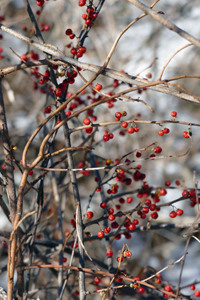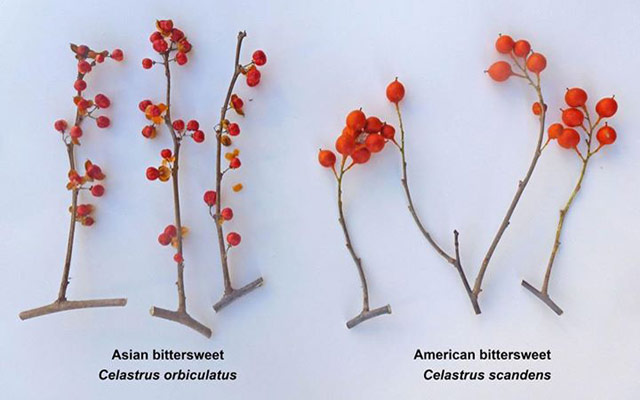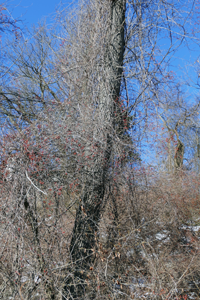

Oriental Bittersweet … The Strangler

Terry Bonace
If you do any gardening or even just walking in Beverly Shores, you are likely to have noticed a vining plant, sometimes just appearing as a short stem from the ground with a tendril at its tip and sometimes as a thick, woody vine climbing all the way to the treetops. In the autumn, you will see that mature vines have a beautiful orange berry that bursts open and reveals a red fruit inside. Many people collect and sell these fruit laden vines for decoration. Unfortunately the beauty of the fruit (and its consumption by many birds) has led to the seeds being widely scattered and germinating in many parts.
Oriental or round-leaved bittersweet (Celastrus orbiculatus) is native to China, Korea and Japan and was introduced to the United States as an ornamental in the late 1800’s. Bittersweet (Celastrus scandens) is a native North American species but quite uncommon in Northwest Indiana. This invasive non-native bittersweet is becoming a serious nuisance and a risk to native plants in Beverly Shores and many other places across the eastern United States.

Oriental bittersweet is a woody vine with leaves arranged alternately along the stem (rather than in pairs). The leaf shape varies from quite round to tapering to a point. Berries occur in clusters along the stem at leaf axils in older plants. The berries are pea sized now and will gradually ripen to a bright orange in September and October. The plant grows in most all habitats in Beverly Shores, except in mud and standing water, being found from dunes to woodlands. Native bittersweet is most easily distinguished from oriental by the fact that the fruit occurs only at the ends of the stems and never in the leaf axils, if you are lucky enough to come across this species. According to the National Lakeshore, the native bittersweet is sometimes found along the sand dunes in the Beverly Shores area.

Oriental Bittersweet can produce thick masses of vines that sprawl over shrubs, small trees and other plants, shading them out and weakening them. Its vines can girdle trees, cutting off the flow of water and nutrients and making the trees particularly vulnerable to damage from ice and windstorms. It can spread from tree to tree in the forest canopy. When one tree falls or is cut down, attached trees may be pulled down too. If you want to see a good example of this, look on the west side of Broadway just north of Leewater where masses of bittersweet can be seen all the way up in to the tree tops. Less than ten years ago, no vines were apparent in this site, so growth is very fast.
Controlling bittersweet can be challenging. Smaller vines pull rather easily from the sandy soils of Beverly Shores. But plants will return or continue to germinate for several years so pulling must persist year to year (think of garlic mustard). For very large, woody vines, an herbicide containing triclopyr can be applied to the folaige of the plant or to the cut stem of the plant.
Vigilant homeowners in Beverly Shores can prevent the destruction of their woodland by removing oriental bittersweet. Because the understories contain a wide variety of vines, mostly native species, and some can look similar to bittersweet, the Environmental Restoration Group (ERG) will be glad to help identify the plant for you. Don't hesitate to contact Terry Bonace (tbonace@gmail.com), Hans Lagoni (hlagoni@comcast.net ) or Bill Schaudt (blschaudt2@gmail.com) for assistance.